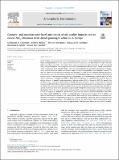Country- and manufacturer-level attribution of air quality impacts due to excess NOx emissions from diesel passenger vehicles in Europe
Author(s)
Chossière, Guillaume P. (Guillaume Pierre); Malina, Robert; Allroggen, Florian; Eastham, Sebastian David; Speth, Raymond L; Barrett, Steven R. H.; ... Show more Show less
DownloadPublished version (1.078Mb)
Terms of use
Metadata
Show full item recordAbstract
In 2015, diesel cars accounted for 41.3% of the total passenger car fleet in Europe. While harmonized emissions limits are implemented at the EU level, on-road emissions of diesel cars have been found to be up to 16 times higher than those measured in test stands. These excess emissions have been estimated to result in increased PM2.5 and ozone exposure causing approximately 5000 premature mortalities per year in Europe. Interventions aimed at mitigating these damages need to take into account the physical and political boundaries in Europe, where emissions from one country may have an impact on neighboring populaces (trans-boundary impacts). To date, the trans-boundary implications of excess NOx emissions in Europe are not understood and only excess NOx emissions have only been studied at the fleet level and for Volkswagen group cars. In this study, a distribution of emission factors is derived from existing on-road measurements for 10 manufacturers, covering 90% of all new vehicle registrations in Europe from 2000 to 2015. These distributions are combined with inventory data and driving behavior to quantify excess emissions of nitrogen oxides (NOx) in Europe in 2015. To quantify the changes in PM2.5 and ozone concentrations resulting from these emissions, we use a state-of-the-art chemical transport model (GEOS-Chem). Concentration-response functions from the epidemiological literature are applied to estimate the premature mortality outcomes and the number of life-years lost associated with degraded air quality. Uncertainty in the input parameters is propagated through the analysis using a Monte Carlo approach. We find that 70% of the total health impacts from excess NOx are due to trans-boundary emissions. For example, 61% of the impacts in Germany of total excess NOx emissions are caused by emissions released in other countries. These results highlight the need for a coordinated policy response at the European level. In addition, we find that total emissions accounting for country-specific fleet mixes and driving behaviors vary between manufacturers by a factor of 10 and mortality impacts per kilometer driven by a factor of 8. Finally, we find that if all manufacturers reduced emissions of the vehicles currently on the road to those of the best-performing manufacturer in the corresponding Euro standard, approximately 1900 premature deaths per year could be avoided.
Date issued
2018-09Department
Massachusetts Institute of Technology. Laboratory for Aviation and the Environment; Massachusetts Institute of Technology. Department of Aeronautics and AstronauticsJournal
Atmospheric Environment
Publisher
Elsevier BV
Citation
Chossière, Guillaume P. et al. "Country- and manufacturer-level attribution of air quality impacts due to excess NOx emissions from diesel passenger vehicles in Europe." Atmospheric Environment 189 (September 2018): 89-97 © 2018 The Authors
Version: Final published version
ISSN
1352-2310